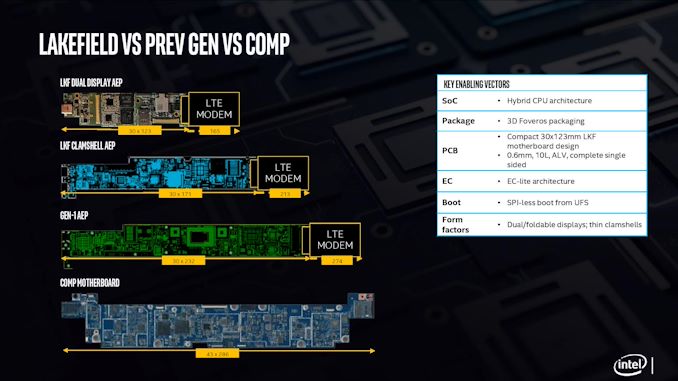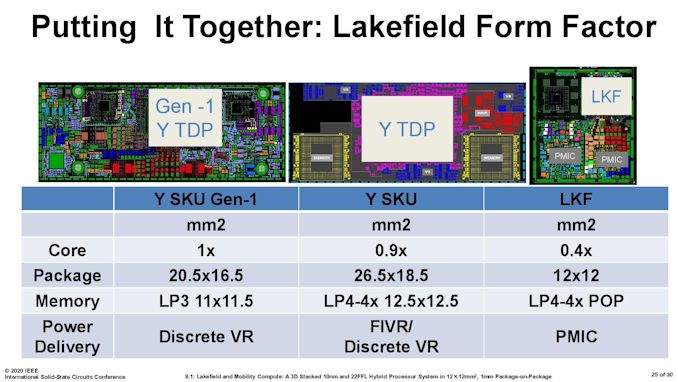The Intel Lakefield Deep Dive: Everything To Know About the First x86 Hybrid CPU
by Dr. Ian Cutress on July 2, 2020 9:00 AM ESTLakefield in Terms of Laptop Size
In a traditional AMD or Intel processor designed for laptops, we experience two to eight processing cores, along with some graphics performance, and it is up to the company to build the chip with the aim of hitting the right efficiency point (15 W, or 35/45 W) to enable the best performance for a given power window. These processors also contain a lot of extra connectivity and functionality, such as a dual channel memory controller, extra PCIe lanes to support external graphics, support for USB port connectivity or an external connectivity hub, or in the case of Intel’s latest designs, support for Thunderbolt built right into the silicon without the need for an external controller. These processors typically have physical dimensions of 150 square millimeters or more, and in a notebook, when paired with the additional power delivery and controllers needed such as Wi-Fi and modems, can tend towards the board inside the system (the motherboard) totaling 15 square inches total.

One of Qualcomm’s examples from 2018
For a Qualcomm processor designed for laptops, the silicon is a paired down to the essentials commonly associated with a smartphone. This means that modem connectivity is built into the processor, and the hardware associated with power delivery and USB are all on the scale of a smartphone. This means a motherboard designed around a Qualcomm processor will be around half the size, enabling different form factors, or more battery capacity in the same size laptop chassis.
With Intel’s new Lakefield processor design, the chip is a lot smaller than previous Intel implementations. The company designed the processor from the ground up, with as much included on the CPU as to not need additional chips on the motherboard, and to fit the dimensions similar to one of Qualcomm’s processors. Above is a slide showing how Intel believes that with an LTE modem included, a Lakefield motherboard can move down to 7.7 square inches, similar to a Qualcomm design. This leaves more room for battery inside a device.
When Intel compares it against its own previous low power CPU implementations, the company quotes a 60% decrease in overall board area compared to its first generation 4.5 W processors.
It is worth noting that for power delivery, Intel placed MIMCAPs inside the Lakefield silicon, much like a smartphone processor, and as a result it can get by on the power delivery implementation with a pair of PMICs (power management ICs). The reason why there is two is because of the two silicon dies inside – they are controlled differently for power for a number of technical reasons. If each layer within an active stacked implementation requires its own PMIC, that would presumably put an upper limit on future stacked designs – I fully expect Intel to be working on some sort of solution for this for it not to be an issue, however that wasn’t implemented in time for Lakefield.
For those that are interested, Lakefield’s PMICs are under the codenames Warren Cove and Castro Cover, and were developed in 2017-2018.












221 Comments
View All Comments
eek2121 - Thursday, July 2, 2020 - link
Right, and AMD has 14nm chips that are 6W. I expect they will be releasing a quad core Zen 2 based product that fits in a 6W power envelope in due time.Jorgp2 - Thursday, July 2, 2020 - link
Lol, no.That's a 6w base clock.
yeeeeman - Friday, July 3, 2020 - link
It might fit into 6W but it won't fit into the same package as LKF. I think people don't understand this is a 1cmx1cm package with basically an entire motherboard worth of components.Spunjji - Friday, July 10, 2020 - link
Definitely not. But is that really all that big of an advantage in a 13" devices that are already hitting the legal limit for battery capacity? It does feel a bit like a solution looking for a problem.The low idle power is a bigger sell, but the performance penalty is a heavy one.
Spunjji - Friday, July 10, 2020 - link
Van Gogh is supposed to be around 9W - I expect they'll probably have knocked-down variants capable of 6W operation.ikjadoon - Thursday, July 2, 2020 - link
And nobody will enjoy running a 7 W to 9.5 W x86 CPU on Windows 10: not in a laptop, not on a tablet, not on a convertible. There is simply too much legacy junk in Windows 10 and this project may only bear fruit in the 2030s, if it's not canned.If these run Windows 10X, perhaps there's a niche market, but Intel is obviously jamming a Hemi engine into a Prius and it looks a last-ditch, mostly fruitless, billion-dollar bet from the outside.
Not unlike Nokia, a few years before completely abandoning their Lumia lineup under MS, decided to invest huge money into Lumia cameras: a lot of money thrown into a pit of fire.
Intel has been unable to "get ready" for the mobile / thin-client era of computing for a decade now.
Meteor2 - Thursday, July 2, 2020 - link
Windows runs just fine on low-powered computers -- as long as there's enough RAM and at least a SATA SSD.Icehawk - Friday, July 3, 2020 - link
Except this maxes out at 8gb which is barely adequate in W10, 16gb is really necessary unless you like to choke or run super lean. My enterprise laptop sits at 6gb after a fresh boot just on the desktop due to all the corporate junk on there - we have some Lenovos with 8gb soldered RAM and they are hot garbage.yeeeeman - Friday, July 3, 2020 - link
I have a 2014 Intel atom z3735f tablet with 2gb of ram and swap handles things pretty well. 8GB of RAM is enough for 95% of people.ProDigit - Friday, July 3, 2020 - link
6GB is what most need for a 64 bit version of windows home.8gb only if you're multitasking.
You could also run linux, and be fine with 2GB.